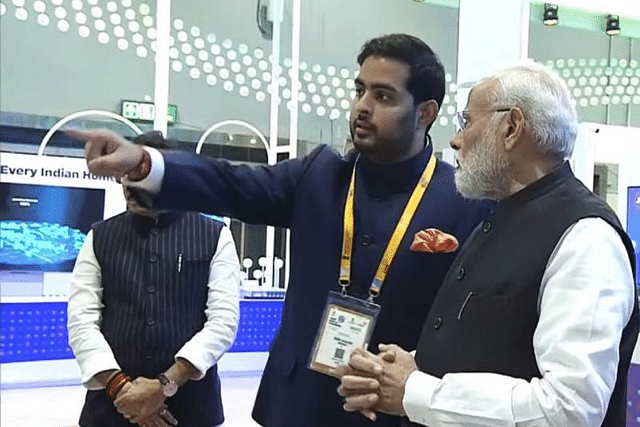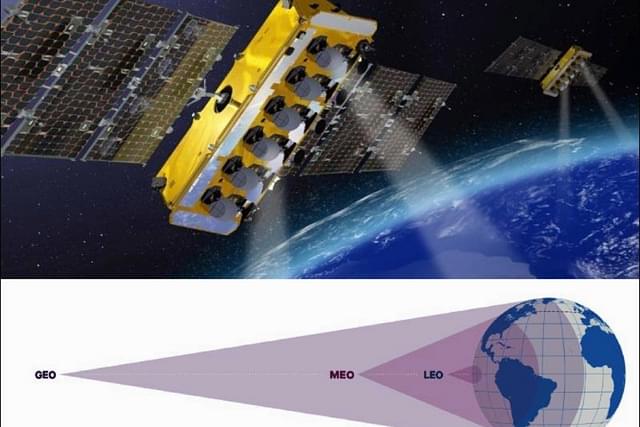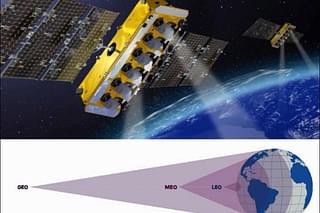Technology
New Broadband Era Dawns As Jio Steals A March Over The Competition, Unveils India’s First Satellite Internet Network
Anand Parthasarathy
Oct 27, 2023, 01:27 PM | Updated 01:27 PM IST
Save & read from anywhere!
Bookmark stories for easy access on any device or the Swarajya app.

Reliance Jio Infocomm, the mobile data arm of Reliance Industries, on Friday (27 October) became the first entity to showcase broadband internet via satellite in India.
The demonstration was staged at the India Mobile Congress that was inaugurated earlier in the day by Prime Minister Narendra Modi, who also visited the Jio stand to briefly witness the demo.
The company states that it has connected four remote locations — Gir in Gujarat, Korba in Chhattisgarh, Nabrangpur in Odisha, and the Oil and Natural Gas Corporation (ONGC) installation in Jorhat, Assam, with what it has christened "JioSpaceFiber."
Rather than loft its own satellites like its main competitor in this space, the Bharti-led OneWeb-Eutelsat combine, Jio has chosen to partner with Luxembourg-headquartered satellite provider SES, which operates geostationary GEO (geosynchronous earth orbit) satellites and medium earth orbit MEO satellites.
For its SpaceFiber offerings in India, Jio will harness the SES MEO O3b and O3b mPOWER satellites, which promise to deliver at gigabit (1,000 MBPS) speeds across land, sea, and space.
LEO, MEO? The Tradeoffs
Unlike the LEO, or low-earth orbit, satellites deployed by most satellite internet providers (including OneWeb), which are required in hundreds to provide a wide swath of coverage while hovering between 600 kilometres (km) and 2,500 km above Earth, MEO satellites are positioned between 5,000 km and 20,000 km above Earth. A relatively smaller number — around six — can provide global coverage.
In comparison, the geostationary, GEO, satellites, which have traditionally been used for communication and television broadcast, are positioned precisely 36,000 km above Earth and only four can cover the entire globe, barring the polar regions.
SES operates both GEO and MEO satellites that will allow Jio, if it chooses, to adjust its services across a broader spectrum of usage than a service that commands only LEO satellites.
However, there is a tradeoff: MEO satellite-based internet has a higher latency; that is, the gap between sending a chunk of data and receiving it is longer.
GEO latency is even worse — remember those small gaps in speech on TV programmes where a correspondent in a distant location talks to a studio anchor?
"JioSpaceFiber will allow everyone, everywhere, to fully participate in the new digital society with gigabit access to online government, education, health, and entertainment services," Reliance Jio Infocomm chairman Akash Ambani said.


Both OneWeb and Jio have obtained letters of intent from the Department of Telecommunications to launch Global Mobile Personal Communications via satellite (GMPCS) in India.
OneWeb has positioned 634 out of a planned 648 LEO satellites and should launch India services anytime now. It is said to be awaiting allocation of spectrum in the Ka/Ku band, which is relatively interference-free.
It looks like 2023 will be the year when India enters the era of satellite-based broadband internet services, which can reach the most remote and unserviced corners of the country.
Save & read from anywhere!
Bookmark stories for easy access on any device or the Swarajya app.
Anand Parthasarathy is managing director at Online India Tech Pvt Ltd and a veteran IT journalist who has written about the Indian technology landscape for more than 15 years for The Hindu.
Support Swarajya's 50 Ground Reports Project & Sponsor A Story
Every general election Swarajya does a 50 ground reports project.
Aimed only at serious readers and those who appreciate the nuances of political undercurrents, the project provides a sense of India's electoral landscape. As you know, these reports are produced after considerable investment of travel, time and effort on the ground.
This time too we've kicked off the project in style and have covered over 30 constituencies already. If you're someone who appreciates such work and have enjoyed our coverage please consider sponsoring a ground report for just Rs 2999 to Rs 19,999 - it goes a long way in helping us produce more quality reportage.
You can also back this project by becoming a subscriber for as little as Rs 999 - so do click on this links and choose a plan that suits you and back us.
Click below to contribute.





